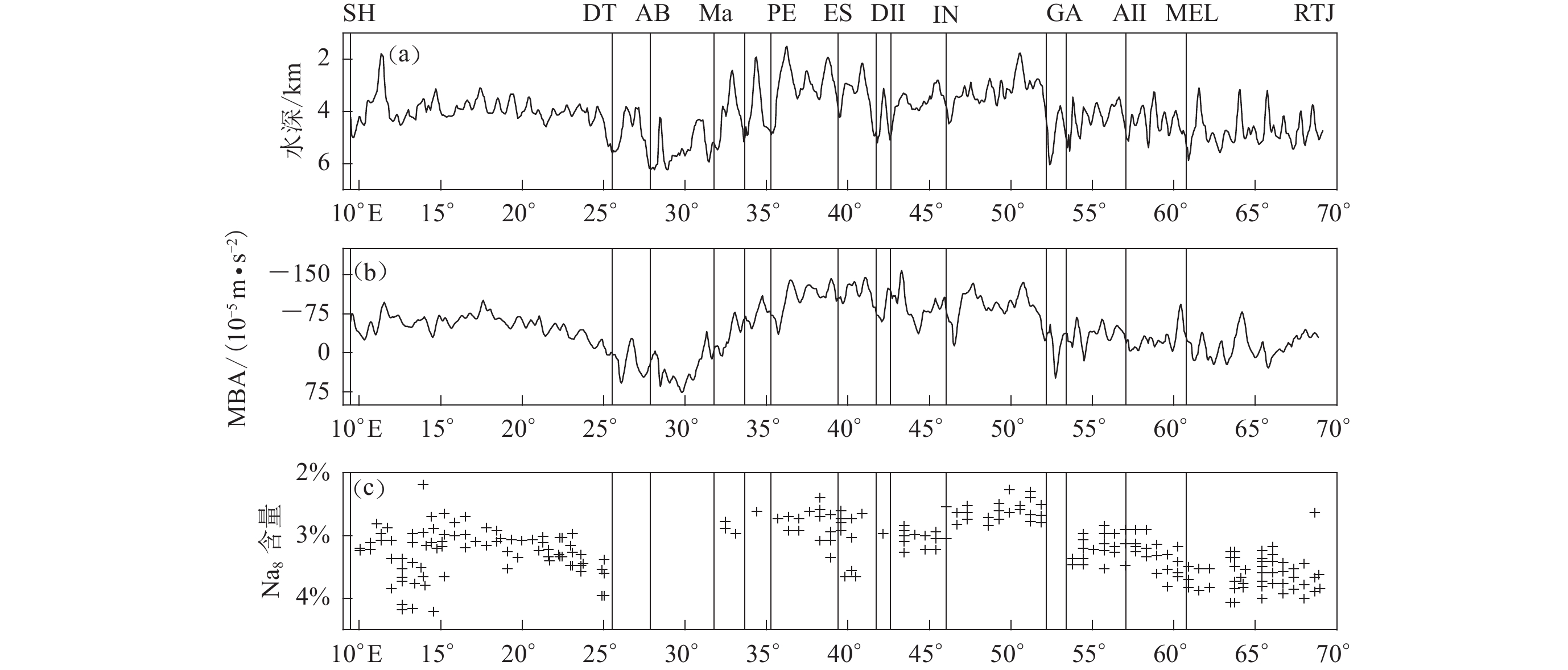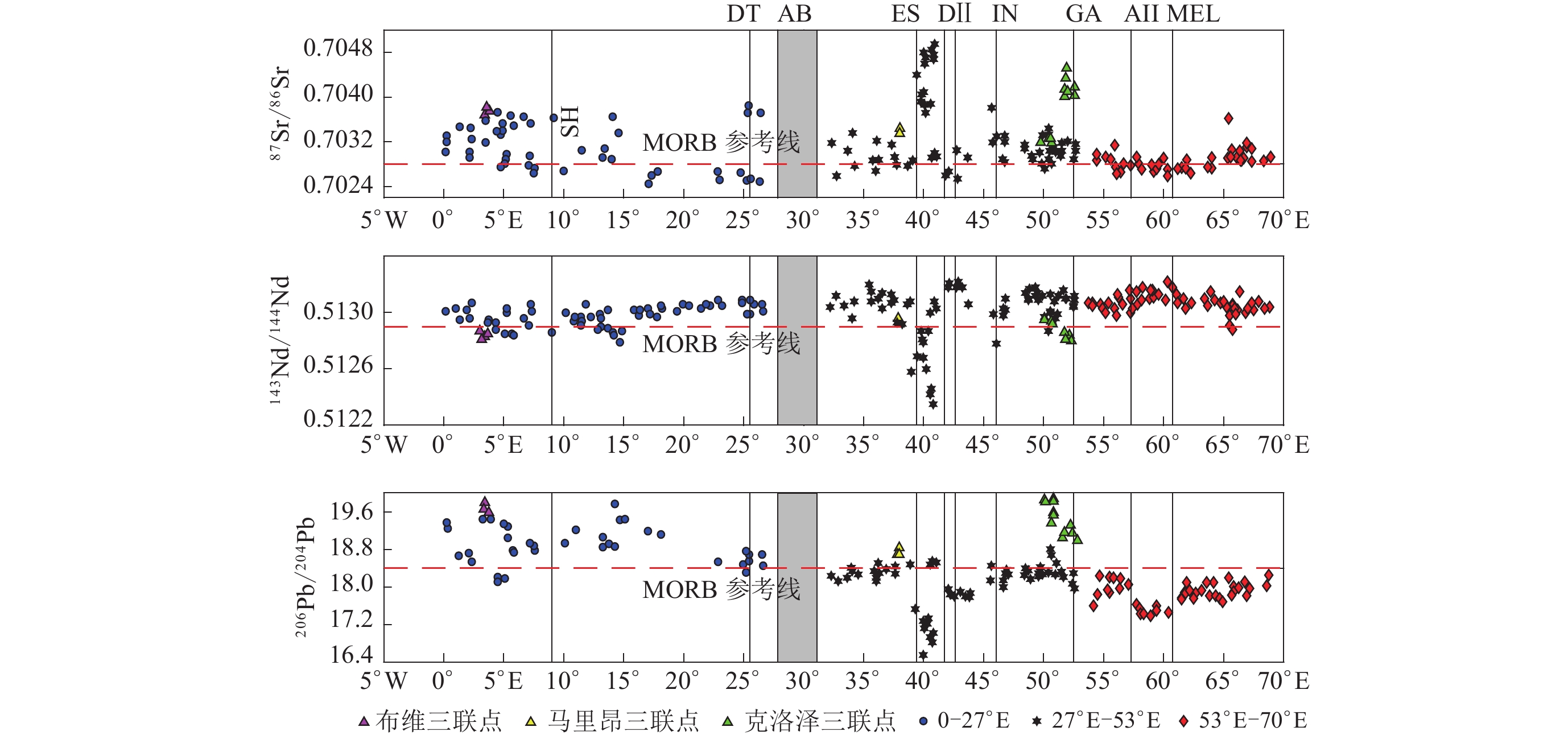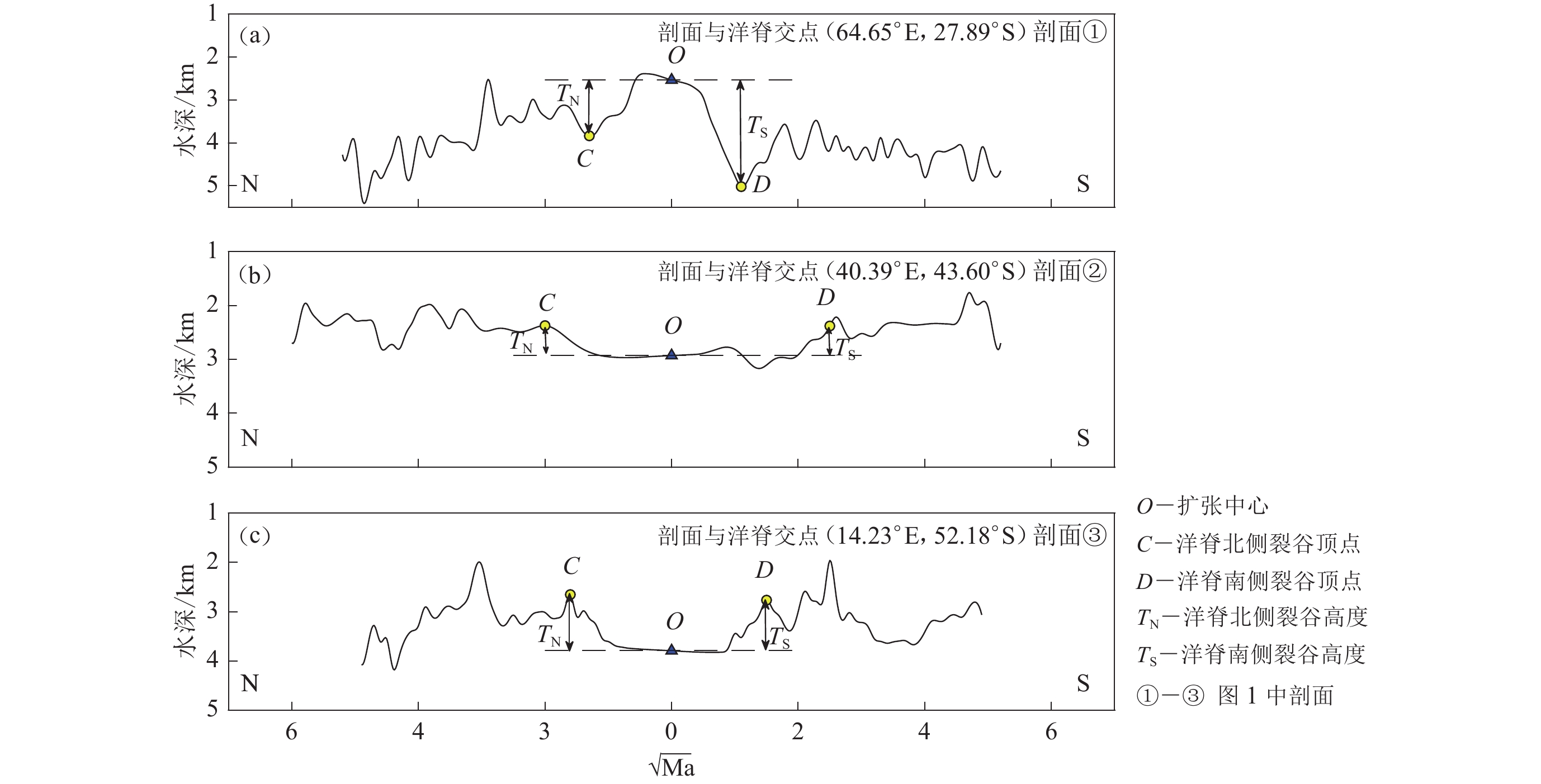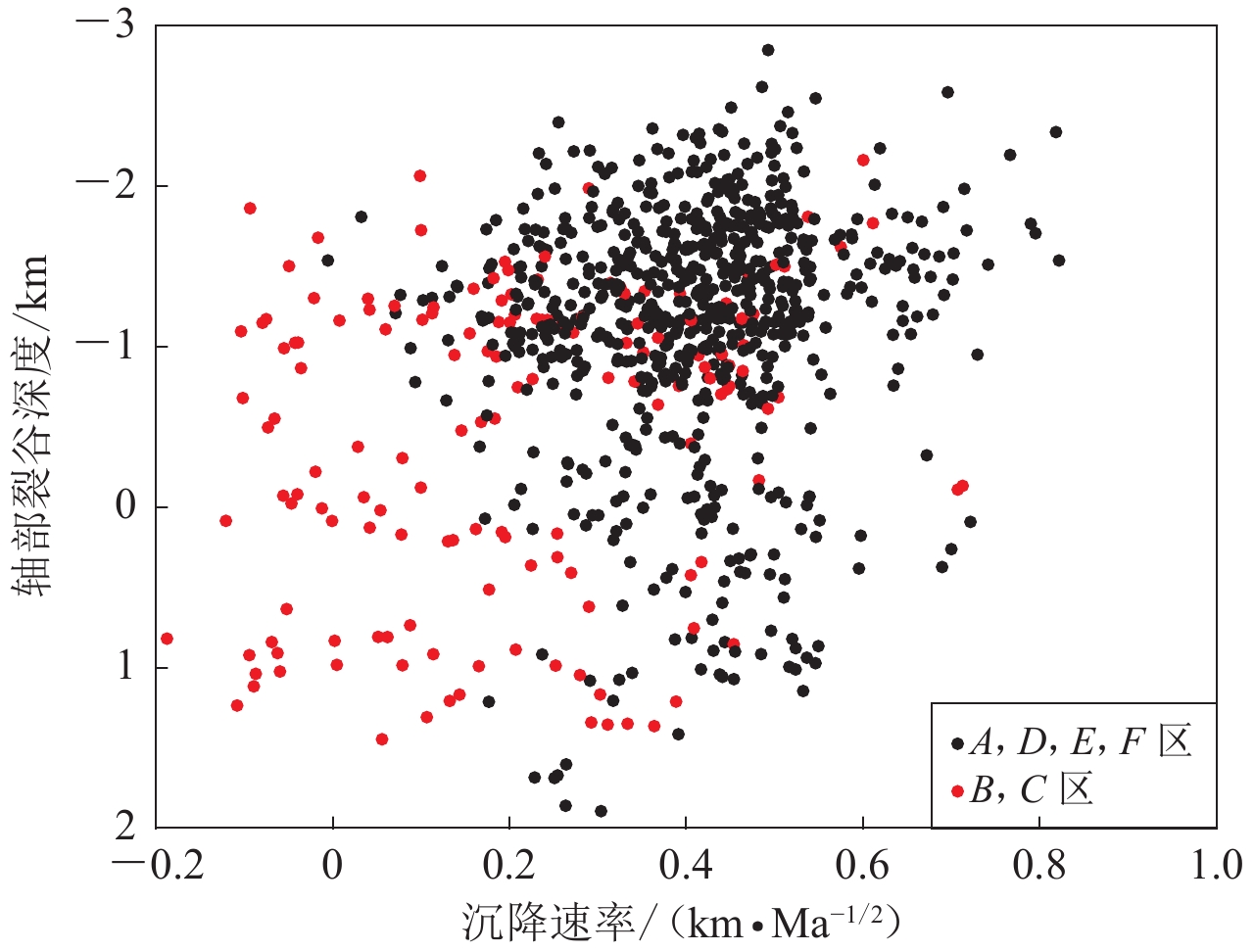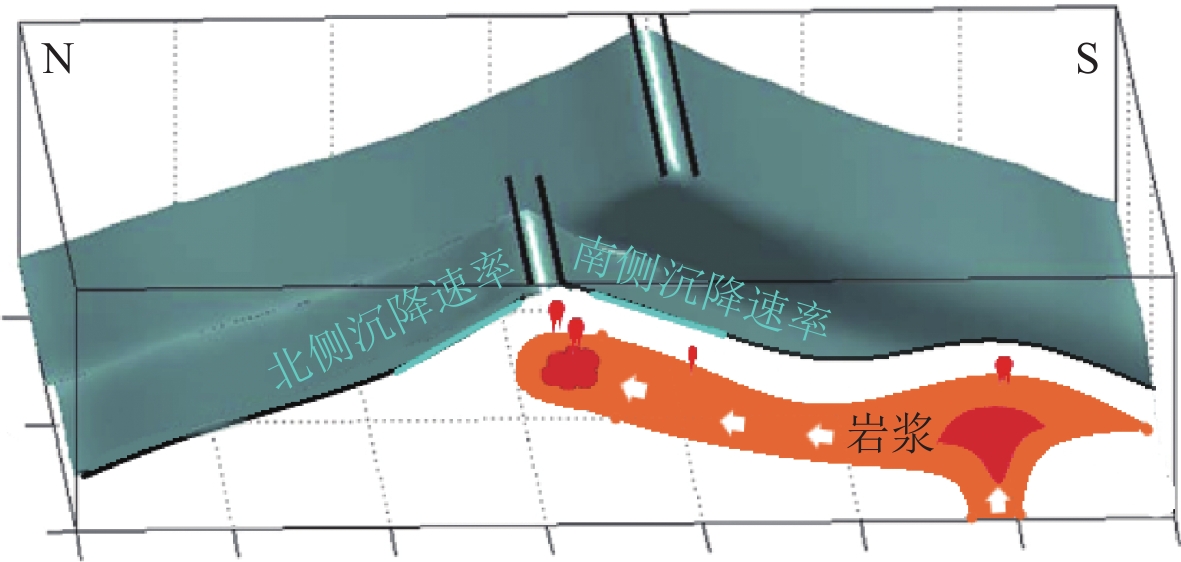Discussion on the interaction between hot spots and mid-ocean ridge from the axial morphology and the variation of subsidence rate on both sides of the Southwest Indian Ridge
-
摘要: 基于高精度地形数据,将西南印度洋中脊(11.88°E—66.75°E)分为6个区域,按不同区域分析洋脊轴部形态及其两侧基底沉降曲线的变化,由此探讨西南印度洋中脊的岩浆活动及其受热点影响的机制。结果显示:① 对于整个西南印度洋中脊,轴部隆起占13.38%,轴部裂谷占82.8%,平坦过渡形占3.82%,其中19°E,36°E,41.2°E,43.7°E,50.4°E和64.5°E等处为较集中的洋脊轴部隆起;② 埃里克辛普森—英多姆转换断层之间的区域(39.4°E—45.77°E)显示出异常浅的轴部裂谷和异常小且南北不对称的基底沉降速率,这表明埃里克辛普森—英多姆转换断层之间的区域是热点对洋中脊影响较为明显的区域,南侧较北侧异常小的基底沉降速率表明热点与洋中脊的相互作用主要表现为热点岩浆从洋中脊南部向上流动到岩石圈底部,然后与岩石圈发生相互作用。
-
关键词:
- 西南印度洋中脊 /
- 洋中脊轴部形态 /
- 基底沉降曲线 /
- 热点与洋中脊相互作用
Abstract: Based on high resolution seafloor bathymetry map, we divided the Southwest Indian Ridg (SWIR) (11.88°E—66.75°E) into six regions. In each region, we estimate the variation of the axial morphology, and the basement subsidence curve over the flanks of the spreading ridge, which can be used to indicate the spreading process of the SWIR and how it was affected by the hot spot. The result shows that: ① For the entire SWIR, axial uplift accounts for 13.38%, axial rift accounts for 82.8%, and flat transitional shape accounts for 3.82%, the areas at 19°E, 36°E, 41.2°E, 43.7°E, 50.4°E, 64.5°E have focus magmatic ridge representing axial ridge uplift; ② The area between the Eric Simpson-Indomed transition faults (39.4°E—45.77°E) shows axial valley with anomalous shallow bathymetry and asymmetrical anomalous low basement subsidence rates between north and south. Therefore, we believe that the area between the Eric Simpson-Indomed transition faults has been significantly affected by the hot spots. Compared with the subsidence rate north of the spreading ridge, the anomalous low subsidence rate in the south indicates that the interaction between the hot spots and the ridge is characterized by the hot spots flowing upward from the south of the SWIR to the bottom of the lithosphere, and then interact with the lithosphere. -
引言
根据不同的扩张速率,全球洋中脊分为快速扩张洋中脊(>60 mm/a)、慢速扩张洋中脊(20—60 mm/a)和超慢速扩张洋中脊(<20 mm/a)(Dick et al,2003)。早期对全球洋中脊的研究主要集中于太平洋的快速扩张洋中脊和大西洋的慢速扩张洋中脊,对超慢速洋中脊的研究相对较少(李三忠等,2015)。全球已知的超慢速洋中脊主要为西南印度洋中脊(Southwest Indian Ridge,缩写为SWIR)和北冰洋的加克洋中脊(Gakkel Ridge,缩写为GR),其中在距今约24 Ma前SWIR的扩张速率从约30 mm/a降为约14 mm/a,进入其超慢速扩张阶段(Baines et al,2007;Patriat et al,2008)。
早期对SWIR的研究大多是探讨其区域性的地球物理和地球化学特征,对于整个洋中脊扩张机制的变化,特别是热点与SWIR相互作用的研究相对较少。地震层析成像、地球物理数据以及地球化学数据表明SWIR的部分区域受到了马里昂(Marion)热点和克洛泽(Crozet)热点的影响(Sauter et al,2009;Zhang et al,2013;孙国洪等,2021),但热点对扩张脊的影响方式以及影响范围还存在争议(Georgen et al,2001;Sauter et al,2009;Zhang et al,2013;Gautheron et al,2015;Yang et al,2017)。
洋中脊地形地貌是研究洋中脊动力学的理想窗口,已有研究发现洋脊扩张中心的地形地貌主要受控于岩浆活动和构造作用(Chen,Morgan,1990a;Buck et al,2005)。相对于快速扩张洋中脊以岩浆作用为主(扩张脊轴部隆起),慢速和超慢速扩张洋中脊受岩浆作用的影响较弱(Dick et al,2003;Sauter et al,2004,2013),洋脊轴部主要为裂谷形态(Lin et al,1990;Sauter et al,2001)。
经典的海底扩张学说认为洋壳的基底深度随着与扩张中心距离的增大而加深。McKenzie (1967)提出的板块冷却模型以及Turcotte和Oxburgh (1969)提出的半空间冷却模型(half space cooling model)都认为海底深度随年龄的平方根呈线性增加(<60 Ma)。最新的全球观测数据表明洋壳的基底深度y与洋壳的年龄t的1/2次方在0—80 Ma为正相关关系,即y=(325±20)×$t^{1/2}+$(2.6±0.2) km (Crosby,McKenzie,2009),其中沉降速率(325±20) km/$\sqrt{{\rm{Ma}}}$主要取决于大洋岩石圈的地幔温度场(Marks,Stock,1994),即洋脊扩张中心处地幔较热、岩石圈厚度较薄,远离扩张中心岩石圈变冷、变厚,并逐渐沉降。但是如果大洋岩石圈结构受到地幔柱或热点的影响,其地幔温度场会发生一定的变化,对应的沉降速率也会发生相应的改变。并且受地幔柱或热点影响的超慢速洋中脊,其扩张轴部的地壳一般较厚,其地貌表现为扩张轴部的隆起(Ito et al,1999)。对于早期热点与SWIR相互作用的研究,层析成像数据的分辨率较低,而地球化学数据在区域性方面受限。本文拟通过定量研究扩张脊轴部形态和扩张中心两侧基底沉降曲线的变化来探讨SWIR (11.88°E—66.75°E)如何受到热点的影响及其受影响的范围。
1. 地质背景
1.1 区域地质背景
西南印度洋中脊(SWIR)的西边界为布维三连点(55°S,00°40′W),东边界为罗得里格斯三连点(25°30′S,70°E)(图1),全长约7 700 km,平均全扩张速率为14.02 mm/a (李三忠等,2015)。SWIR中段(34°E—52°E)环绕着海底高原,其南侧较近的有德尔卡诺海隆、克洛泽高原,北侧较近的有马达加斯加高原(余星等,2020)。SWIR的转换断层十分发育,本文研究区内即有11条转换断层(图1)(Georgen et al,2001)。研究表明SWIR的地壳厚度和地幔温度自西向东呈减少和下降的趋势(Cannat et al,1999;Meyzen et al,2005;Font et al,2007)。SWIR中部(安德鲁贝恩—加列尼)玄武岩Na8的含量和地幔布格重力异常(mantle Bouguer anomaly,缩写为MBA)与整个洋脊相比都为低值,暗示较高的地幔熔融温度(Sauter et al,2009;Sauter,Cannat,2010)(图2)。而SWIR东部(加列尼转换断层以东)Na8值与MBA都较中部高(图2)。Niu等(2015)在SWIR 49°17′E—50°49′E处开展的精细广角地震调查确定了在SWIR岩浆供给充足的地方(50°28′E)其地壳厚度可以达到10.2 km;而位于49°39′E的三维地壳结构显示其地壳厚度从洋脊段中心的7—8 km降至洋脊尾段的3—4 km (Zhao et al,2013);在66°E和57°E处开展的海底水听器(ocean bottom hydrophone,缩写为OBH)地震调查得到的地壳厚度为2.2—5.4 km (Muller et al,1997,2000;Minshull et al,2006)。上述研究表明虽然SWIR的扩张速率变化不大,但是其沿轴的地壳厚度变化很大。西南印度洋中脊玄武岩(mid-ocean ridge basalt,缩写为MORB)的地球化学成分变化较大,既包括(La/Sm)N<1的正常型MORB (N-MORB),又包括(La/Sm)N>1的富集型MORB (E-MORB),反映了地幔的非均一性(孙国洪等,2021),其Sr-Nd-Pb同位素比值变化范围为87Sr/86Sr为0.70248—0.70520;143Nd/144Nd为0.51237—0.51322;206Pb/204Pb为16.58—19.66。
![]() 图 1 西南印度洋地形图及分区SWIR:西南印度洋中脊;SEIR:东南印度洋中脊;CIR:中印度洋中脊;BTJ:布维三连点;RTJ:罗得里格斯三连点;SH:沙卡;DT:迪图瓦;AB:安德鲁贝恩;M:马里昂;PE:爱德华王子;ES:埃里克辛普森;DII:发现Ⅱ号;IN:英多姆;GA:加列尼;AII:亚特兰提斯Ⅱ号;MEL:梅尔。下同Figure 1. Topographic map of Southwest Indian OceanSWIR:Southwest Indian Ridge;SEIR:Southeast Indian Ridge;CIR:Central Indian Ridge;BTJ:Bouvet Triple Junction;RTJ:Rodriguez Triple Junction;SH:Shaka;DT:Du Toit;AB:Andrew Bain;M:Marion;PE:Prince Edward;ES:Eric Simpson;DII:Discovery Ⅱ ;IN:Indomed;GA:Gallieni;AII:Atlantis Ⅱ ;MEL:Melville. The same below
图 1 西南印度洋地形图及分区SWIR:西南印度洋中脊;SEIR:东南印度洋中脊;CIR:中印度洋中脊;BTJ:布维三连点;RTJ:罗得里格斯三连点;SH:沙卡;DT:迪图瓦;AB:安德鲁贝恩;M:马里昂;PE:爱德华王子;ES:埃里克辛普森;DII:发现Ⅱ号;IN:英多姆;GA:加列尼;AII:亚特兰提斯Ⅱ号;MEL:梅尔。下同Figure 1. Topographic map of Southwest Indian OceanSWIR:Southwest Indian Ridge;SEIR:Southeast Indian Ridge;CIR:Central Indian Ridge;BTJ:Bouvet Triple Junction;RTJ:Rodriguez Triple Junction;SH:Shaka;DT:Du Toit;AB:Andrew Bain;M:Marion;PE:Prince Edward;ES:Eric Simpson;DII:Discovery Ⅱ ;IN:Indomed;GA:Gallieni;AII:Atlantis Ⅱ ;MEL:Melville. The same below![]() 图 2 SWIR沿轴水深、地幔布格重力异常MBA和玄武岩Na8含量变化图(修改自Sauter,Cannat,2010)图中纵向灰色实线为转换断层位置。(a) 沿轴水深;(b) 沿轴MBA变化(Georgen et al,2001);(c) 玄武岩Na8含量变化Figure 2. Variation of the depth,MBA,Na8 composition of basalts along the SWIR axis(modified after Sauter,Cannat,2010)The vertical gray solid line indicates the location of transform faults. (a) Depth;(b) Mantle Bouguer anomaly (Georgen et al,2001); (c) Na8 composition of basalts
图 2 SWIR沿轴水深、地幔布格重力异常MBA和玄武岩Na8含量变化图(修改自Sauter,Cannat,2010)图中纵向灰色实线为转换断层位置。(a) 沿轴水深;(b) 沿轴MBA变化(Georgen et al,2001);(c) 玄武岩Na8含量变化Figure 2. Variation of the depth,MBA,Na8 composition of basalts along the SWIR axis(modified after Sauter,Cannat,2010)The vertical gray solid line indicates the location of transform faults. (a) Depth;(b) Mantle Bouguer anomaly (Georgen et al,2001); (c) Na8 composition of basalts1.2 热点的影响
早期研究表明SWIR中部受到了马里昂热点和克洛泽热点的影响。马里昂热点是一个古老的热点(90 Ma)(Storey et al,1995),对SWIR地形地貌产生了巨大影响,例如马达加斯加高原和德尔卡诺海隆的形成都与马里昂热点有关(Zhang et al,2011)。同位素定年数据显示马里昂热点最新活动时间小于0.45 Ma (McDougall et al,2001)。根据剩余地幔布格重力异常(residual mantle Bouguer anomaly,缩写为RMBA)的变化情况,安德鲁贝恩和发现Ⅱ号转换断层被认为是马里昂热点对洋脊影响的两个边界(Georgen et al,2001)。这段洋脊也表现出“热点异常特征”,即:高87Sr/86Sr、高206Pb/204Pb和低143Nd/144Nd (图3)。
![]() 图 3 西南印度洋中脊玄武岩同位素比值变化图(修改自孙国洪等,2021)Figure 3. Variations in isotopic ratios of MORBs along SWIR (modified after Sun et al,2021)
图 3 西南印度洋中脊玄武岩同位素比值变化图(修改自孙国洪等,2021)Figure 3. Variations in isotopic ratios of MORBs along SWIR (modified after Sun et al,2021)地球物理数据显示在英多姆和加列尼转换断层间的脊段具有异常低的RMBA,可能表明该区域受到了克洛泽热点的影响(Zhang et al,2013),此段洋脊丰富的热液资源(Tao et al,2012)可能与克洛泽热点有关。但该洋脊段却没有发现E-MORB的地球化学证据。Yang等(2017)支持该洋脊段受到克洛泽热点的影响,认为在克洛泽热点物质流向洋中脊的过程中,减压熔融未能影响其同位素的组成特征(Sauter et al,2009;Gautheron et al,2015;Yang et al,2017)。李三忠等(2015)认为克洛泽热点与洋脊的相互作用可以归属于弱热点与洋中脊相互作用一类。而Ruan等(2017)和胡昊(2020)用远震接收函数方法,揭示了SWIR和克洛泽热点地幔过渡带厚度减薄现象,推算出两个区域的地幔过渡带具有相近温度正异常,从而否定了克洛泽热点向SWIR岩浆运移的假设。Li等(2015)在SWIR 50°28'E处发现地壳厚度为9.5 km,在其下方4—9 km处发现低速异常区并认为是岩浆房(Niu et al,2015;Jian et al,2017a,b),这为克洛泽热点影响了英多姆—加列尼转化断层段洋脊提供了地球物理数据的佐证。
2. SWIR分段
前人对SWIR的分段主要依据大错距转换断层的分布和水深的区域性变化(Sauter et al,2001;Mendel et al,2003),本文根据转换断层对地形起伏的影响进行分段。图4为以发现Ⅱ号转换断层为中心沿洋脊中轴的水深变化情况(发现Ⅱ号以西为负,以东为正),并取SWIR中轴距离热点最近的点为其投影点,SWIR与马里昂热点的最小距离约为243 km,与克洛泽热点的最小距离约为724 km。由图4可以看出对地形起伏影响较大的有5个转换断层,即安德鲁贝恩、发现Ⅱ号、英多姆、加列尼和亚特兰蒂斯Ⅱ号。根据这5个转换断层将洋中脊分为6个研究区域,自西向东分别为A区11.88°E—24.85°E,B区35.74°E—41.43°E,C区43.21°E—45.77°E,D区46.68°E—52.02°E,E区52.40°E—56.76°E,F区57.22°E—66.75°E (图1,图4)。
![]() 图 4 沿西南印度洋中脊的水深拟合图红色实线为最佳高斯拟合线;灰色条带为转换断层发育位置;红色条带为热点投影到洋中脊的位置;A,B,C,D,E,F为洋脊研究分区Figure 4. Fitting diagram of seafloor depth along SWIRThe solid red line is the best Gaussian fitting line;the gray stripes indicate the location of transition faults;the red stripe is the location where the plume is projected onto the mid-ocean ridge; A,B,C,D,E,F are the segmented study areas
图 4 沿西南印度洋中脊的水深拟合图红色实线为最佳高斯拟合线;灰色条带为转换断层发育位置;红色条带为热点投影到洋中脊的位置;A,B,C,D,E,F为洋脊研究分区Figure 4. Fitting diagram of seafloor depth along SWIRThe solid red line is the best Gaussian fitting line;the gray stripes indicate the location of transition faults;the red stripe is the location where the plume is projected onto the mid-ocean ridge; A,B,C,D,E,F are the segmented study areas3. 数据与方法
3.1 数据来源
本次研究采用的地形数据是美国斯克利普斯海洋研究所(Scripps Institution of Oceanography,缩写为SIO)发布的topo15.grd (SIO,2023)。地壳年龄数据和洋中脊扩张方向数据是Seton等(2020)发布的age.2020.1.GTS2021.2m.grd和dir.2020.1.GeeK2007.6m.nc,其中地形数据的分辨率是15′′,年龄的分辨率为2′,扩张方向数据分辨率为6′。该分辨率足以满足本次研究中扩张轴部地形形貌的观测以及扩张脊两侧的基底沉降曲线的计算。
3.2 计算方法
3.2.1 轴部裂谷深度
为了精细地探测洋脊轴部地形以及扩张轴两侧基底沉降曲线沿洋中脊从西向东的变化,将沿洋脊的采样间隔设为5 km (图5相邻红色圆点的间距)。由这些点沿洋中脊的扩张方向(Sauter et al,2004;李三忠等,2015;Seton et al,2020)向南北各延伸250 km (约25 Ma),从而得到跨过洋中脊的地形剖面。其中扩张方向与磁异常条带近似垂直(图5b)。为了弱化洋中脊三连点对研究的影响,我们分别去除靠近布维三连点与罗得里格斯三连点的部分洋中脊(图1)。此外,我们还去除了安德鲁贝恩转换断层附近受多个大型转换断层影响的洋中脊段(图1)。最终共获得860条横跨洋中脊的剖面。
![]() 图 5 沿西南印度洋中脊采样以及扩张方向示意图(a) 水深地形图;(b) 磁异常分布图,磁异常数据来源于全球2′分辨率磁力网格数据EMAG2 (Maus et al,2009)Figure 5. Schematic diagram of sampling along SWIR and its spreading direction(a) Topographic map;(b) The magnetic anomalies map,and the magnetic anomaly data are from EMAG2 (Maus et al,2009)
图 5 沿西南印度洋中脊采样以及扩张方向示意图(a) 水深地形图;(b) 磁异常分布图,磁异常数据来源于全球2′分辨率磁力网格数据EMAG2 (Maus et al,2009)Figure 5. Schematic diagram of sampling along SWIR and its spreading direction(a) Topographic map;(b) The magnetic anomalies map,and the magnetic anomaly data are from EMAG2 (Maus et al,2009)图6展示了参考Anderson等(2017)定义地形参数的方法来确定的横跨SWIR的三种典型剖面。其中O点为扩张中心,C点为北边谷壁顶点,D点为南边谷壁顶点。C点相对O点的垂直深度为TN,D点相对O点的垂直深度为TS (谷壁顶点深度减去扩张中心深度)。轴部裂谷深度T为TN和TS的平均值。当T≥100 m时,扩张中心代表岩浆供给充足的轴部隆起(图6a);当−100 m<T<100 m时为轴部隆起与轴部凹陷的过渡态,即较为平缓的“一”字形(图6b);当T≤−100 m时代表岩浆供给不足的轴部凹陷(图6c)。
3.2.2 沉降速率
由于SWIR及其250 km以内沉积物较少(<200 m)(Whittaker et al,2013;Dutkiewicz et al,2017),因此我们可以将海底深度等同于基底深度。早期的研究表明,受大洋板块半冷却空间模型的影响,基底深度与洋壳年龄的1/2次幂正相关(Parson,Sclater,1997;Stein,Stein,1992;Crosby,McKenzie,2009)。我们取洋脊两侧大于4 Ma (去除轴部裂谷的影响)的年龄的平方根与基底深度作散点拟合(多项式一阶)(Crosby,McKenzie,2009),得到其沉降线性方程式为
$$ y=k\sqrt{t}+b \text{,} $$ (1) 式中:$ y $为基底深度,单位为km;$ t $为洋壳年龄,单位为Ma;$ k $为沉降速率,单位为km/$\sqrt {{\rm{Ma}}} $;$ b $为基底初始深度,单位为km。获得的拟合线如图7所示。
4. 结果
4.1 SWIR轴部裂谷深度的特征及变化情况
图8展现了洋中脊轴部形态的变化情况,轴部隆起占比13.38%,主要集中在19°E,36.1°E,41.2°E,43.7°E,50.4°E,64.5°E处。较深的轴部凹陷(图6c)占比为82.8%。两者的过渡形态,其轴部地形较为平坦(图6b),占比3.82%。SWIR研究区域内轴部裂谷深度T的平均值为−1.0 km。A区轴部隆起占A区采样点总数的8.73%,B区占其28%,C区占39.5%,D区占12.28%,E区没有轴部隆起,F区占11.72%。
通过洋中脊轴部隆起情况可以推断,19°E,36.1°E,41.2°E,43.7°E,50.4°E,64.5°E处较SWIR其它地方可能具有更为集中的岩浆供应。
图9给出了轴部裂谷深度与距马里昂热点和克洛泽热点距离的关系,本文以洋脊距热点1 000 km处 (本文将1 000 km作为热点影响的极限距离)为界将SWIR分为Ⅰ区和Ⅱ区两部分,距马里昂热点1 000 km内的Ⅰ区平均轴部裂谷深度为−0.45 km,Ⅱ区平均轴部裂谷深度为−1.11 km。Ⅰ区轴部隆起占SWIR采样点总数的5.53%,占Ⅰ区采样点数的30.13%;轴部凹陷和过渡形态占SWIR采样点总数的12.79%。距马里昂热点超过1 000 km的Ⅱ区轴部隆起占SWIR采样点总数的8.09%,占Ⅱ区采样点数的9.91%;轴部凹陷和过渡形态占SWIR采样点总数的73.59% (图9a)。
距克洛泽热点1 000 km内的Ⅰ区平均轴部裂谷深度为−0.66 km,1 000 km外的Ⅱ区平均轴部裂谷深度为−1.12 km。Ⅰ区轴部隆起占SWIR采样点总数的6.23%,占Ⅰ区采样点数的22.55%;轴部凹陷和过渡形态占SWIR采样点总数的21.36%。Ⅱ区轴部隆起占SWIR采样点总数的7.39%,占Ⅱ区采样点数的10.21%;轴部凹陷和过渡形态占采样点总数的65.02% (图9b)。
4.2 SWIR沉降速率的特征及变化情况
图10显示了SWIR沉降速率在不同区域的变化情况。SWIR平均沉降速率为0.368 km/$\sqrt{{\rm{Ma}}} $,A区域的平均沉降速率为0.393 km/$\sqrt{{\rm{Ma}}} $,B,C,D区域的平均沉降速率为0.29 km/$\sqrt{{\rm{Ma}}} $,E和F区域的平均沉降速率为0.415 km/$\sqrt{{\rm{Ma}}} $,其中:A,D,E和F区的沉降速率较为稳定,介于0.3—0.5 km/$\sqrt{{\rm{Ma}}} $之间,与全球实际观测的沉积速率值(0.325±0.2 km/$\sqrt{{\rm{Ma}}} $)基本吻合(Crosby,McKenzie,2009);而B区和C区的沉降速率出现异常小的值。埃里克辛普森—英多姆段(39.4°E—45.8°E,蓝色方框)是沉降速率异常小的区域(0.097 4 km/$\sqrt{{\rm{Ma}}} $),此区域洋脊南北两侧的沉降速率有较为明显的差异,其中北侧的平均沉降速率为0.179 km/$\sqrt{{\rm{Ma}}} $,而南侧平均沉降速率仅为0.044 km/$\sqrt{{\rm{Ma}}} $ (图10b蓝色方框),并且大部分北侧沉降速率大于南侧。
![]() 图 10 SWIR沉降速率图图(a)中红色实线为各研究区域内沉降速率的拟合线,品红色虚线为SWIR沉降速率平均值,蓝色阴影为全球沉降速率均值范围(Stein,Stein,1992;Crosby,McKenzie,2009);图(b)中蓝色和黑针线分别为洋中脊北侧沉降速率减去南侧所得的正值与负值,灰色及红色条带与图4同。顶部红色区域显示洋脊轴部隆起所占比例(a) 沉降速率沿轴变化图;(b) 洋脊两侧沉降速率差值沿轴变化图Figure 10. SWIR sedimentation rate diagramIn fig.(a),the solid red line is the best fit line of the subsidence rate along the SWIR, the red dotted line shows an average SWIR subsidence rate,while the horizontal blue stripes represent the global subsidence rate (Stein, Stein,1992;Crosby,McKenzie,2009);In fig.(b),the black and blue lines indicate the values of difference between the northern and southern subsidence rate. The vertical gray and red stripes indicate the same meaning as in fig.4. The red areas at top represent the percentage of the axial rise for each region. (a) Subsidence rate variation along SWIR;(b) Axial variation of the difference between northern and southern subsidence rate
图 10 SWIR沉降速率图图(a)中红色实线为各研究区域内沉降速率的拟合线,品红色虚线为SWIR沉降速率平均值,蓝色阴影为全球沉降速率均值范围(Stein,Stein,1992;Crosby,McKenzie,2009);图(b)中蓝色和黑针线分别为洋中脊北侧沉降速率减去南侧所得的正值与负值,灰色及红色条带与图4同。顶部红色区域显示洋脊轴部隆起所占比例(a) 沉降速率沿轴变化图;(b) 洋脊两侧沉降速率差值沿轴变化图Figure 10. SWIR sedimentation rate diagramIn fig.(a),the solid red line is the best fit line of the subsidence rate along the SWIR, the red dotted line shows an average SWIR subsidence rate,while the horizontal blue stripes represent the global subsidence rate (Stein, Stein,1992;Crosby,McKenzie,2009);In fig.(b),the black and blue lines indicate the values of difference between the northern and southern subsidence rate. The vertical gray and red stripes indicate the same meaning as in fig.4. The red areas at top represent the percentage of the axial rise for each region. (a) Subsidence rate variation along SWIR;(b) Axial variation of the difference between northern and southern subsidence rate图11给出了洋脊两侧沉降速率与距马里昂热点和克洛泽热点距离的关系,本文以距热点1 000 km处为界将SWIR分为Ⅰ区和Ⅱ区两部分,距马里昂热点1 000 km内的Ⅰ区平均沉降速率为0.205 km/$\sqrt{{\rm{Ma}}} $,Ⅱ区平均沉降速率为0.399 km/$\sqrt{{\rm{Ma}}} $。Ⅰ区沉降速率小于B,C,D区平均沉降速率0.29 km/$\sqrt{{\rm{Ma}}} $ 的占SWIR采样点总数的12.5%,占Ⅰ区采样点数的65.38%;沉降速率大于或等于0.29 km/$\sqrt{{\rm{Ma}}} $ 的占SWIR采样点总数的6.61%。Ⅱ区沉降速率小于0.29 km/$\sqrt{{\rm{Ma}}} $ 的占SWIR采样点总数的15.93%,占Ⅱ区采样点数的19.69%;沉降速率大于或等于0.29 km/$\sqrt{{\rm{Ma}}} $ 的占SWIR采样点总数的64.96% (图11a)。
距克洛泽热点1 000 km内的Ⅰ区平均沉降速率为0.265 km/$\sqrt{{\rm{Ma}}} $,1 000 km外的Ⅱ区平均沉降速率为0.402 km/$\sqrt{{\rm{Ma}}} $。Ⅰ区沉降速率小于0.29 km/$\sqrt{{\rm{Ma}}} $ 的占SWIR采样点总数的14.46%,占Ⅰ区采样点数的50.21%;沉降速率大于或等于0.29 km/$\sqrt{{\rm{Ma}}} $ 的占SWIR采样点总数的14.34%。Ⅱ区沉降速率小于0.29 km/$\sqrt{{\rm{Ma}}} $ 的占SWIR采样点总数的13.97%,占Ⅱ区采样点数的19.62%;沉降速率大于或等于0.29 km/$\sqrt{{\rm{Ma}}} $ 的占SWIR采样点总数的57.23% (图11b)。
5. 讨论与结论
5.1 SWIR沿轴岩浆活动情况
研究表明当扩张速率低于20 mm/a时,由于地幔岩浆上涌速度较慢,受到地表热传导冷却作用的影响强烈,导致上涌地幔的温度快速降低,从而造成扩张洋中脊下方的岩石圈快速增厚(White et al,1992)。较厚的岩石圈其弹性厚度较大,可以承受较大的动态应力,维持更大的断层间距、落差和弹性挠曲(Tapponnier,Francheteau,1978;Lin,Parmentier,1989;Chen,Morgan,1990a,b),承载的扩张轴部裂谷一般更深。如果洋脊在扩张过程中受到高温热点或地幔成分异常的影响,会产生较厚的洋壳从而减弱岩石圈的强度,使扩张轴部裂谷更浅甚至出现隆起形态(Sloan et al,2012)。本文研究结果显示19°E,36°E,41.2°E,43.7°E,50.4°E和64.5°E表现为轴部隆起,暗示这些地方的岩浆供应可能更为集中,岩浆活动较SWIR其它区域更为强烈(图8)。例如地震资料显示50.4°E及其附近的地壳厚度为10.4 km (Niu et al,2015),并且具有大量的岩浆(Li et al,2015;Jian et al,2017a,b)。此外F区相比其它区域有较多随机分布的轴部隆起,可能是受到罗得里格斯三连点的影响(余星等,2020),在57°E和66°E处的地震数据显示了较薄的地壳厚度(Muller et al,1997,2000;Minshull et al,2006),与我们的结果基本吻合(无轴部隆起)。图9a中距马里昂热点近的Ⅰ区(包括B,C区域)岩浆活动(30.13%)明显强于Ⅱ区(9.91%),图9b中距克洛泽热点1 000 km 内的Ⅰ区(包括部分B,C,D区域)的岩浆活动同样强于Ⅱ区,说明SWIR较强的岩浆活动与热点有一定的关系。B,C区的轴部隆起比例是各研究区域中最高的,分别为28%和39.58% (图10a),且玄武岩Na8的含量和地幔布格重力异常(MBA)与整个洋脊相比都为低值(图2),表明此区域岩浆供应是SWIR最充足的,很有可能受到马里昂热点和克洛泽热点的影响。
5.2 SWIR沿轴基底沉降速率变化情况
本研究获得的SWIR平均沉降速率(0.368 km/$\sqrt{{\rm{Ma}}} $)与Stein和Stein (1992)的结果(0.365 km/$\sqrt{{\rm{Ma}}} $)类似,但大于最新的全球平均沉降速率0.325 km/$\sqrt{{\rm{Ma}}} $ (Crosby,McKenzie,2009)。我们的结果表明B区(0.244 km/$\sqrt{{\rm{Ma}}} $)和C区(0.129 km/$\sqrt{{\rm{Ma}}} $)具有异常小的沉降速率(图10),特别是在埃里克辛普森—英多姆(39.4°E—45.8°E)处,其沉降速率(0.0974 km/$\sqrt{{\rm{Ma}}} $)最小,并且洋脊南侧沉降速率(0.044 km/$\sqrt{{\rm{Ma}}} $)显著小于北侧沉降速率(0.179 km/$\sqrt{{\rm{Ma}}} $)。距马里昂热点和克洛泽热点较近的Ⅰ区沉降速率小于B,C,D区平均沉降速率0.29 km/$\sqrt{{\rm{Ma}}} $ 的比例都明显高于Ⅱ区(图11),由此推测异常小的沉降速率有可能是热点导致。
早期的研究指出沉降速率的变化反映了其对应的地幔温度结构相对于半冷却模型的变化(Marks,Stock,1994),而埃里克辛普森-英多姆转换断层区域异常低的沉降速率表明此区域地幔温度高,并且洋中脊南侧的地幔温度高于北侧。结合热点位置(位于SWIR南侧)及此区域较高的87Sr/86Sr和较低的143Nd/144Nd (图3),我们认为埃里克辛普森-英多姆段洋脊很有可能受到马里昂热点和克洛泽热点的影响。异常热的热点使洋脊及洋脊两侧岩石圈(特别是南侧)温度升高,从而造成沉降速率显著降低。埃里克辛普森—英多姆转换断层可能为热点影响边界,与前人研究认为转换断层能够有效地阻挡热点岩浆的流动的观点(Vogt,Johnson,1975;Georgen et al,2001;Georgen,2014)一致。
5.3 热点对SWIR影响范围及方式
马里昂热点和克洛泽热点对SWIR的影响存在较多的争议:Georgen等(2001)认为安德鲁贝恩和发现Ⅱ号转换断层是马里昂热点东西两侧影响的边界;Zhang等(2013)认为克洛泽热点对SWIR的影响范围在英多姆—加列尼转换断层之间;Niu等(2015)认为SWIR 50°E处受到克洛泽热点的作用;刘持恒等(2018)认为马里昂热点和克洛泽热点的影响范围分别约550 km和900 km;胡昊(2020)认为克洛泽热点的影响主要是浅层的,深部岩浆远距离迁移的可能性不大。本次研究通过分析整个SWIR扩张轴部的形态及其两侧的基底沉降速率,对SWIR和热点的相互作用机制有了新的认识。表1展现了SWIR各研究区域的轴部裂谷深度和沉降速率的平均值。B区和C区较SWIR其它区域,其轴部深度最浅、基底沉降速率最小(图12红点),因此热点对SWIR的主要影响区域在B区和C区。其中埃里克辛普森-英多姆(39.4°E—45.77°E)段洋脊沉降速率异常低(图10)且南侧沉降速率明显小于北侧,表明埃里克辛普森—英多姆(39.4°E—45.8°E)区域为热点影响显著的区域。由于埃里克辛普森-英多姆区域距离马里昂热点和克洛泽热点都小于1 000 km,位于热点影响显著的Ⅰ区(图9,图11),因此该区域可能同时受到马里昂热点和克洛泽热点的影响。
表 1 SWIR各研究区域的扩张轴部深度及沉降速率均值表Table 1. Axial valley depth and subsidence rate of each area in SWIR各研究分区 轴部裂谷深度/km 沉降速率/(km·Ma−1/2) A区 −1.09 0.393 B区 −0.48 0.244 C区 −0.37 0.129 D区 −0.95 0.407 E区 −1.40 0.420 F区 −1.14 0.414 SWIR −1.00 0.368 基于简单的二维数值模拟,早期的研究表明,热点与洋中脊的相互作用主要表现为热点岩浆沿着洋中脊流动(Yale,Morgan,1998),扩张脊下方的地幔温度场会显著地受到热点岩浆的影响。但是大量的研究又表明在热点的熔融过程中,热点的脱水过程造成热点岩浆的黏度以102的倍数增加(Hirth,Kohlstedt,1996),从而形成高黏度地幔层,并且能够有效地阻止热点岩浆的向上流动(Ito et al,1999)。因此热点与洋中脊的相互作用表现为热点岩浆在地幔深处(深度>100 km)呈水平状的放射性流动(Albers,Christensen,2001)。这种情况下,扩张洋中脊下方的地幔温度场主要受扩张作用的影响。
本文结果显示,在受热点影响的埃里克辛普森—英多姆段,其两侧的基底沉降速率为0.129—0.244 km/$\sqrt {{\rm{Ma}}} $,远远小于全球的平均沉降速率值(0.325±0.02 )km/$\sqrt {{\rm{Ma}}} $。异常小的沉降速率表明该区域的热点与洋中脊的相互作用主要表现为热点岩浆从SWIR南部向上流动到岩石圈底部,并且与岩石圈发生相互作用,从而改变了扩张作用形成的半空间冷却模型的地幔温度场,造成异常低的基底沉降速率值。其次,受热点影响的区域主要位于埃里克辛普森和英多姆两个大型转换断层之间,表明热点岩浆沿着洋中脊流动受到埃里克辛普森和英多姆两个转换断层的阻挡(图13)。
5.4 结论
本文利用高精度地形数据定量研究了SWIR 11.88°E—66.75°E之间的轴部地形地貌,将其分为轴部隆起、轴部凹陷和平坦过渡型三种类型,统计各类结果所在区域及其占比,并计算洋中脊两侧基底沉降速率,得到以下结论:
1) SWIR轴部隆起占13.38%,轴部凹陷占82.8%,平坦过渡形占3.82%,其中SWIR 19°E,36°E,41.2°E,43.7°E,50.4°E和64.5°E区域主要表现为轴部隆起,暗示岩浆供应较为集中。
2) 埃里克辛普森—英多姆转换断层限定的区域(39.4°E—45.77°E)是热点对西南印度洋中脊影响显著的区域,主要表现为该区域的基底沉降速率异常小,轴部裂谷深度异常浅,以及洋中脊南侧的基底沉降速率(0.044 km/$\sqrt {{\rm{Ma}}} $)明显小于北侧(0.179 km/$\sqrt {{\rm{Ma}}} $)。
3) 异常小的基底沉降速率以及南北沉降速率的非对称性表明热点与洋中脊的相互作用主要表现为热点岩浆从西南印度洋中脊南部向上流动到岩石圈底部,然后与岩石圈发生相互作用。
部分图件使用了GMT绘图软件(Wessel,Smith,1995),审稿专家在本文撰写过程中提出了宝贵的意见,作者在此一并表示感谢。
-
图 1 西南印度洋地形图及分区
SWIR:西南印度洋中脊;SEIR:东南印度洋中脊;CIR:中印度洋中脊;BTJ:布维三连点;RTJ:罗得里格斯三连点;SH:沙卡;DT:迪图瓦;AB:安德鲁贝恩;M:马里昂;PE:爱德华王子;ES:埃里克辛普森;DII:发现Ⅱ号;IN:英多姆;GA:加列尼;AII:亚特兰提斯Ⅱ号;MEL:梅尔。下同
Figure 1. Topographic map of Southwest Indian Ocean
SWIR:Southwest Indian Ridge;SEIR:Southeast Indian Ridge;CIR:Central Indian Ridge;BTJ:Bouvet Triple Junction;RTJ:Rodriguez Triple Junction;SH:Shaka;DT:Du Toit;AB:Andrew Bain;M:Marion;PE:Prince Edward;ES:Eric Simpson;DII:Discovery Ⅱ ;IN:Indomed;GA:Gallieni;AII:Atlantis Ⅱ ;MEL:Melville. The same below
图 2 SWIR沿轴水深、地幔布格重力异常MBA和玄武岩Na8含量变化图(修改自Sauter,Cannat,2010)
图中纵向灰色实线为转换断层位置。(a) 沿轴水深;(b) 沿轴MBA变化(Georgen et al,2001);(c) 玄武岩Na8含量变化
Figure 2. Variation of the depth,MBA,Na8 composition of basalts along the SWIR axis(modified after Sauter,Cannat,2010)
The vertical gray solid line indicates the location of transform faults. (a) Depth;(b) Mantle Bouguer anomaly (Georgen et al,2001); (c) Na8 composition of basalts
图 3 西南印度洋中脊玄武岩同位素比值变化图(修改自孙国洪等,2021)
Figure 3. Variations in isotopic ratios of MORBs along SWIR (modified after Sun et al,2021)
图 4 沿西南印度洋中脊的水深拟合图
红色实线为最佳高斯拟合线;灰色条带为转换断层发育位置;红色条带为热点投影到洋中脊的位置;A,B,C,D,E,F为洋脊研究分区
Figure 4. Fitting diagram of seafloor depth along SWIR
The solid red line is the best Gaussian fitting line;the gray stripes indicate the location of transition faults;the red stripe is the location where the plume is projected onto the mid-ocean ridge; A,B,C,D,E,F are the segmented study areas
图 5 沿西南印度洋中脊采样以及扩张方向示意图
(a) 水深地形图;(b) 磁异常分布图,磁异常数据来源于全球2′分辨率磁力网格数据EMAG2 (Maus et al,2009)
Figure 5. Schematic diagram of sampling along SWIR and its spreading direction
(a) Topographic map;(b) The magnetic anomalies map,and the magnetic anomaly data are from EMAG2 (Maus et al,2009)
图 10 SWIR沉降速率图
图(a)中红色实线为各研究区域内沉降速率的拟合线,品红色虚线为SWIR沉降速率平均值,蓝色阴影为全球沉降速率均值范围(Stein,Stein,1992;Crosby,McKenzie,2009);图(b)中蓝色和黑针线分别为洋中脊北侧沉降速率减去南侧所得的正值与负值,灰色及红色条带与图4同。顶部红色区域显示洋脊轴部隆起所占比例(a) 沉降速率沿轴变化图;(b) 洋脊两侧沉降速率差值沿轴变化图
Figure 10. SWIR sedimentation rate diagram
In fig.(a),the solid red line is the best fit line of the subsidence rate along the SWIR, the red dotted line shows an average SWIR subsidence rate,while the horizontal blue stripes represent the global subsidence rate (Stein, Stein,1992;Crosby,McKenzie,2009);In fig.(b),the black and blue lines indicate the values of difference between the northern and southern subsidence rate. The vertical gray and red stripes indicate the same meaning as in fig.4. The red areas at top represent the percentage of the axial rise for each region. (a) Subsidence rate variation along SWIR;(b) Axial variation of the difference between northern and southern subsidence rate
表 1 SWIR各研究区域的扩张轴部深度及沉降速率均值表
Table 1 Axial valley depth and subsidence rate of each area in SWIR
各研究分区 轴部裂谷深度/km 沉降速率/(km·Ma−1/2) A区 −1.09 0.393 B区 −0.48 0.244 C区 −0.37 0.129 D区 −0.95 0.407 E区 −1.40 0.420 F区 −1.14 0.414 SWIR −1.00 0.368 -
胡昊. 2020. 用OBS远震接收函数方法研究西南印度洋中脊深部结构及洋脊-热点相互作用[D]. 杭州: 浙江大学: 94–99. Hu H. 2020. Using OBS Teleseismic Receiver Function to Study the Deep Structure of the Southwest Indian Ridge and Interaction of the Ridge-Hotspot System[D]. Hangzhou: Zhejiang University: 94–99 (in Chinese).
李三忠,索艳慧,余珊,赵淑娟,戴黎明,曹花花,张臻,刘为勇,张国堙. 2015. 西南印度洋构造地貌与构造过程[J]. 大地构造与成矿学,39(1):15–29. doi: 10.3969/j.issn.1001-1552.2015.01.002 Li S Z,Suo Y H,Yu S,Zhao S J,Dai L M,Cao H H,Zhang Z,Liu W Y,Zhang G Y. 2015. Morphotectonics and tectonic processes of the southwest Indian Ocean[J]. Geotectonica et Metallogenia,39(1):15–29 (in Chinese).
刘持恒,李江海,张华添,刘仲兰,范庆凯. 2018. 西南印度洋岩浆补给特征研究:来自洋壳厚度的证据[J]. 地球物理学报,61(7):2859–2870. Liu C H,Li J H,Zhang H T,Liu Z L,Fan Q K. 2018. Magma supply of the southwest Indian Ocean:Evidence from crustal thickness anomalies[J]. Chinese Journal of Geophysics,61(7):2859–2870 (in Chinese).
孙国洪,田丽艳,李小虎,张汉羽,陈凌轩,刘红玲. 2021. 西南印度洋中脊岩石地球化学特征及其岩浆作用研究[J]. 海洋地质与第四纪地质,41(5):126–138. Sun G H,Tian L Y,Li X H,Zhang H Y,Chen L X,Liu H L. 2021. A review of studies on the magmatism at Southwest Indian Ridge from petrological and geochemical perspectives[J]. Marine Geology &Quaternary Geology,41(5):126–138 (in Chinese).
余星,迪克·亨利,李小虎,初凤友,董彦辉,胡航. 2020. 西南印度洋中脊地质构造特征及其地球动力学意义[J]. 地球物理学报,63(10):3585–3603. Yu X,Dick H,Li X H,Chu F Y,Dong Y H,Hu H. 2020. The geotectonic features of the Southwest Indian Ridge and its geodynamic implications[J]. Chinese Journal of Geophysics,63(10):3585–3603 (in Chinese).
Albers M,Christensen U R. 2001. Channeling of plume flow beneath mid-ocean ridges[J]. Earth Planet Sci Lett,187(1/2):207–220.
Anderson M O,Chadwick Jr W W,Hannington M D,Merle S G,Resing J A,Baker E T,Butterfield D A,Walker S L,Augustin N. 2017. Geological interpretation of volcanism and segmentation of the Mariana back-arc spreading center between 12.7°N and 18.3°N[J]. Geochem,Geophys,Geosyst,18(6):2240–2274.
Baines A G,Cheadle M J,Dick H J B,Scheirer A H,John B E,Kusznir N J,Matsumoto T. 2007. Evolution of the Southwest Indian Ridge from 55°45′E to 62°E:Changes in plate-boundary geometry since 26 Ma[J]. Geochem,Geophys,Geosyst,8(6):Q06022.
Buck W R,Lavier L L,Poliakov A N B. 2005. Modes of faulting at mid-ocean ridges[J]. Nature,434(7034):719–723. doi: 10.1038/nature03358
Cannat M,Rommevaux-Jestin C,Sauter D,Deplus C,Mendel V. 1999. Formation of the axial relief at the very slow spreading Southwest Indian Ridge (49° to 69°E)[J]. J Geophys Res:Solid Earth,104(B10):22825–22843. doi: 10.1029/1999JB900195
Chen Y S,Morgan W J. 1990a. A nonlinear rheology model for mid-ocean ridge axis topography[J]. J Geophys Res,95(B11):17583–17604. doi: 10.1029/JB095iB11p17583
Chen Y S,Morgan W J. 1990b. Rift valley/no rift valley transition at mid-ocean ridges[J]. J Geophys Res:Solid Earth,95(B11):17571–17581. doi: 10.1029/JB095iB11p17571
Crosby A G,McKenzie D. 2009. An analysis of young ocean depth,gravity and global residual topography[J]. Geophys J Int,178(3):1198–1219. doi: 10.1111/j.1365-246X.2009.04224.x
Dick H J B,Lin J,Schouten H. 2003. An ultraslow-spreading class of ocean ridge[J]. Nature,426(6965):405–412. doi: 10.1038/nature02128
Dutkiewicz A,Müller R D,Wang X,O’Callaghan S,Cannon J,Wright N M. 2017. Predicting sediment thickness on vanished ocean crust since 200 Ma[J]. Geochem,Geophys,Geosyst,18(12):4586–4603.
Font L,Murton B J,Roberts S,Tindle A G. 2007. Variations in melt productivity and melting conditions along SWIR (70°E–49°E):Evidence from olivine-hosted and plagioclase-hosted melt inclusions[J]. J Petrol,48(8):1471–1494. doi: 10.1093/petrology/egm026
Gautheron C,Moreira M,Gerin C,Tassan-Got L,Bezos A,Humler E. 2015. Constraints on the DUPAL anomaly from helium isotope systematics in the Southwest Indian mid-ocean ridge basalts[J]. Chem Geol,417:163–172. doi: 10.1016/j.chemgeo.2015.10.005
Georgen J E,Lin J,Dick H J B. 2001. Evidence from gravity anomalies for interactions of the Marion and Bouvet hotspots with the Southwest Indian Ridge:Effects of transform offsets[J]. Earth Planet Sci Lett,187(3/4):283–300.
Georgen J E. 2014. Interaction of a mantle plume and a segmented mid-ocean ridge:Results from numerical modeling[J]. Earth Planet Sci Lett,392:113–120. doi: 10.1016/j.jpgl.2014.01.035
Hirth G,Kohlstedt D L. 1996. Water in the oceanic upper mantle:Implications for rheology,melt extraction and the evolution of the lithosphere[J]. Earth Planet Sci Lett,144(1/2):93–108.
Ito G,Shen Y,Hirth G,Wolfe C J. 1999. Mantle flow,melting,and dehydration of the Iceland mantle plume[J]. Earth Planet Sci Lett,165(1):81–96. doi: 10.1016/S0012-821X(98)00216-7
Jian H C,Singh S C,Chen Y J,Li J B. 2017a. Evidence of an axial magma chamber beneath the ultraslow-spreading Southwest Indian Ridge[J]. Geology,45(2):143–146. doi: 10.1130/G38356.1
Jian H C,Chen Y J,Singh S C,Li J B,Zhao M H,Ruan A G,Qiu X L. 2017b. Seismic structure and magmatic construction of crust at the ultraslow-spreading Southwest Indian Ridge at 50°28′E[J]. J Geophys Res:Solid Earth,122(1):18–42. doi: 10.1002/2016JB013377
Li J B,Jian H C,Chen Y J,Singh S C,Ruan A G,Qiu X L,Zhao M H,Wang X G,Niu X W,Ni J Y,Zhang J Z. 2015. Seismic observation of an extremely magmatic accretion at the ultraslow spreading Southwest Indian Ridge[J]. Geophys Res Lett,42(8):2656–2663. doi: 10.1002/2014GL062521
Lin J,Parmentier E M. 1989. Mechanisms of lithospheric extension at mid-ocean ridges[J]. Geophys J Int,96(1):1–22. doi: 10.1111/j.1365-246X.1989.tb05246.x
Lin J,Purdy G M,Schouten H,Sempere J C,Zervas C. 1990. Evidence from gravity data for focused magmatic accretion along the Mid-Atlantic Ridge[J]. Nature,344(6267):627–632. doi: 10.1038/344627a0
Marks K M,Stock J M. 1994. Variations in ridge morphology and depth-age relationships on the Pacific-Antarctic Ridge[J]. J Geophys Res:Solid Earth,99(B1):531–541. doi: 10.1029/93JB02760
Maus S,Barckhausen U,Berkenbosch H,Bournas N,Brozena J,Childers V,Dostaler F,Fairhead J D,Finn C,von Frese R R B,Gaina C,Golynsky S,Kucks R,Lühr H,Milligan P,Mogren S,Müller R D,Olesen O,Pilkington M,Saltus R,Schreckenberger B,Thébault E,Caratori Tontini F. 2009. EMAG2:A 2–arc min resolution Earth Magnetic Anomaly Grid compiled from satellite,airborne,and marine magnetic measurements[J]. Geochem,Geophys,Geosyst,10(8):Q08005.
McDougall I A N,Verwoerd W,Chevallier L U C. 2001. K-Ar geochronology of Marion Island,Southern Ocean[J]. Geol Mag,138(1):1–17. doi: 10.1017/S0016756801005039
McKenzie D P. 1967. Some remarks on heat flow and gravity anomalies[J]. J Geophys Res,72(24):6261–6273. doi: 10.1029/JZ072i024p06261
Mendel V, Sauter D, Rommevaux-Jestin C, Patriat P, Lefebvre F, Parson L M. 2003. Magmato-tectonic cyclicity at the ultra-slow spreading Southwest Indian Ridge: Evidence from variations of axial volcanic ridge morphology and abyssal hills pattern[J]. Geochem, Geophys, Geosyst, 4(5): 9102.
Meyzen C M, Ludden J N, Humler E, Luais B, Toplis M J, Mével C, Storey M. 2005. New insights into the origin and distribution of the DUPAL isotope anomaly in the Indian Ocean mantle from MORB of the Southwest Indian Ridge[J]. Geochem, Geophys, Geosyst, 6(11): Q11K11.
Minshull T A,Muller M R,White R S. 2006. Crustal structure of the Southwest Indian Ridge at 66°E:Seismic constraints[J]. Geophys J Int,166(1):135–147. doi: 10.1111/j.1365-246X.2006.03001.x
Muller M R,Robinson C J,Minshull T A,White R S,Bickle M J. 1997. Thin crust beneath ocean drilling program borehole 735B at the Southwest Indian Ridge?[J]. Earth Planet Sci Lett,148(1/2):93–107.
Muller M R,Minshull T A,White R S. 2000. Crustal structure of the Southwest Indian Ridge at the Atlantis II fracture zone[J]. J Geophys Res:Solid Earth,105(B11):25809–25828. doi: 10.1029/2000JB900262
Niu X W,Ruan A G,Li J B,Minshull T A,Sauter D,Wu Z L,Qiu X L,Zhao M H,Chen Y J,Singh S. 2015. Along-axis variation in crustal thickness at the ultraslow spreading Southwest Indian Ridge (50°E) from a wide-angle seismic experiment[J]. Geochem,Geophys,Geosyst,16(2):468–485.
Parson B,Sclater J G. 1997. An analysis of the variation of ocean floor bathymetry and heat flow with age[J]. J Geophys Res,82(5):803–827.
Patriat P,Sloan H,Sauter D. 2008. From slow to ultraslow:A previously undetected event at the Southwest Indian Ridge at ca. 24 Ma[J]. Geology,36(3):207–210. doi: 10.1130/G24270A.1
Ruan A G,Hu H,Li J B,Niu X W,Wei X D,Zhang J,Wang A X. 2017. Crustal structure and mantle transition zone thickness beneath a hydrothermal vent at the ultra-slow spreading Southwest Indian Ridge (49°39′E):A supplementary study based on passive seismic receiver functions[J]. Mar Geophys Res,38(1):39–46.
Sauter D,Patriat P,Rommevaux-Jestin C,Cannat M,Briais A,Gallieni Shipboard Scientific Party. 2001. The Southwest Indian Ridge between 49°15′E and 57°E:Focused accretion and magma redistribution[J]. Earth Planet Sci Lett,192(3):303–317. doi: 10.1016/S0012-821X(01)00455-1
Sauter D, Carton H, Mendel V, Munschy M, Rommevaux-Jestin C, Schott J J, Whitechurch H. 2004. Ridge segmentation and the magnetic structure of the Southwest Indian Ridge (at 50°30′E, 55°30′E and 66°20′E): Implications for magmatic processes at ultraslow-spreading centers[J]. Geochem, Geophys, Geosyst, 5(5): Q05K08.
Sauter D,Cannat M,Meyzen C,Bezos A,Patriat P,Humler E,Debayle E. 2009. Propagation of a melting anomaly along the ultraslow Southwest Indian Ridge between 46°E and 52°20′E:Interaction with the Crozet hotspot?[J]. Geophys J Int,179(2):687–699. doi: 10.1111/j.1365-246X.2009.04308.x
Sauter D, Cannat M. 2010. The ultraslow spreading Southwest Indian ridge[G]//Diversity of Hydrothermal Systems on Slow Spreading Ocean Ridges. Washington: American Geophysical Union: 153–173.
Sauter D,Cannat M,Rouméjon S,Andreani M,Birot D,Bronner A,Brunelli D,Carlut J,Delacour A,Guyader V,MacLeod C J,Manatschal G,Mendel V,Ménez B,Pasini V,Ruellan E,Searle R. 2013. Continuous exhumation of mantle-derived rocks at the Southwest Indian Ridge for 1 1 million years[J]. Nat Geosci,6(4):314–320. doi: 10.1038/ngeo1771
Scripps Institution of Oceanography, University of California San Diego. 2023. Index of /pub/archive/srtm15/V1[EB/OL]. [2022-08-23]. https://topex.ucsd.edu/pub/archive/srtm15/V1/
Seton M, Müller R D, Zahirovic S, Williams S, Wright N M, Cannon J, Whittaker J M, Matthews K J, McGirr R. 2020. A global data set of present-day oceanic crustal age and seafloor spreading parameters[J]. Geochem, Geophys, Geosyst, 21(10): e2020GC009214.
Sloan H,Sauter D,Goff J A,Cannat M. 2012. Abyssal hill characterization at the ultraslow spreading Southwest Indian Ridge[J]. Geochem,Geophys,Geosyst,13(2):Q0AE06.
Stein C A,Stein S. 1992. A model for the global variation in oceanic depth and heat flow with lithospheric age[J]. Nature,359(6391):123–129. doi: 10.1038/359123a0
Storey M,Mahoney J J,Saunders A D,Duncan R A,Kelley S P,Coffin M F. 1995. Timing of hot spot-related volcanism and the breakup of Madagascar and India[J]. Science,267(5199):852–855. doi: 10.1126/science.267.5199.852
Tao C H,Lin J,Guo S Q,Chen Y J,Wu G H,Han X Q,German C R,Yoerger D R,Zhou N,Li H M,Su X,Zhu J,the DY115-19 (Legs 1–2) and DY115-20 (Legs 4–7) Science Parties. 2012. First active hydrothermal vents on an ultraslow-spreading center:Southwest Indian Ridge[J]. Geology,40(1):47–50. doi: 10.1130/G32389.1
Tapponnier P,Francheteau J. 1978. Necking of the lithosphere and the mechanics of slowly accreting plate boundaries[J]. J Geophys Res:Solid Earth,83(B8):3955–3970. doi: 10.1029/JB083iB08p03955
Turcotte D L,Oxburgh E R. 1969. Convection in a mantle with variable physical properties[J]. J Geophys Res,74(6):1458–1474. doi: 10.1029/JB074i006p01458
Vogt P R,Johnson G L. 1975. Transform faults and longitudinal flow below the Midoceanic Ridge[J]. J Geophys Res,80(11):1399–1428. doi: 10.1029/JB080i011p01399
Wessel P, Smith W H F. 1995. New version of the generic mapping tools[J]. Eos, Trans Am Geophys Union, 76(33): 329.
White R S,McKenzie D,O’Nions R K. 1992. Oceanic crustal thickness from seismic measurements and rare earth element inversions[J]. J Geophys Res:Solid Earth,97(B13):19683–19715. doi: 10.1029/92JB01749
Whittaker J M,Goncharov A,Williams S E,Müller R D,Leitchenkov G. 2013. Global sediment thickness data set updated for the Australian-Antarctic Southern Ocean[J]. Geochem,Geophys,Geosyst,14(8):3297–3305.
Yale M M,Morgan J P. 1998. Asthenosphere flow model of hotspot-ridge interactions:A comparison of Iceland and Kerguelen[J]. Earth Planet Sci Lett,161(1/2/3/4):45–56.
Yang A Y,Zhao T P,Zhou M F,Deng X G. 2017. Isotopically enriched N-MORB:A new geochemical signature of off-axis plume-ridge interaction:A case study at 50°28′E,Southwest Indian Ridge[J]. J Geophys Res:Solid Earth,122(1):191–213.
Zhang T,Lin J,Gao J Y. 2011. Interactions between hotspots and the Southwest Indian Ridge during the last 90 Ma:Implications on the formation of oceanic plateaus and intra-plate seamounts[J]. Science China Earth Sciences,54(8):1177–1188. doi: 10.1007/s11430-011-4219-9
Zhang T,Lin J,Gao J Y. 2013. Magmatism and tectonic processes in Area A hydrothermal vent on the Southwest Indian Ridge[J]. Science China Earthquake Science,56(12):2186–2197. doi: 10.1007/s11430-013-4630-5
Zhao M H,Qiu X L,Li J B,Sauter D,Ruan A G,Chen J,Cannat M,Singh S,Zhang J Z,Wu Z L,Niu X W. 2013. Three-dimensional seismic structure of the Dragon Flag oceanic core complex at the ultraslow spreading Southwest Indian Ridge (49°39′E)[J]. Geochem,Geophys,Geosyst,14(10):4544–4563.





 下载:
下载:
